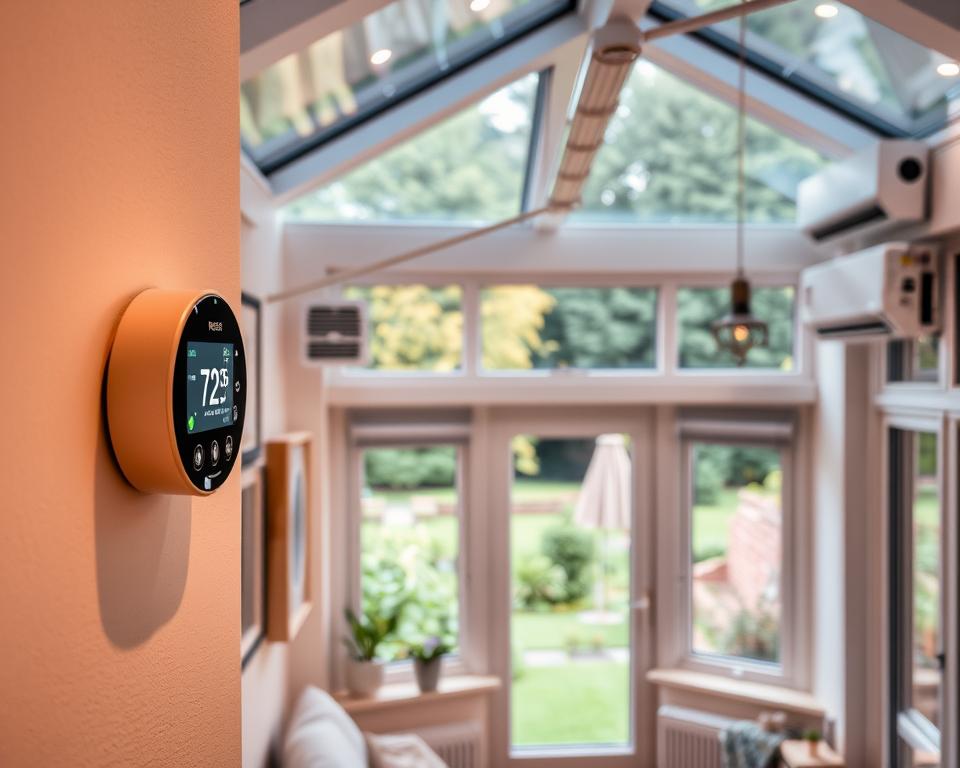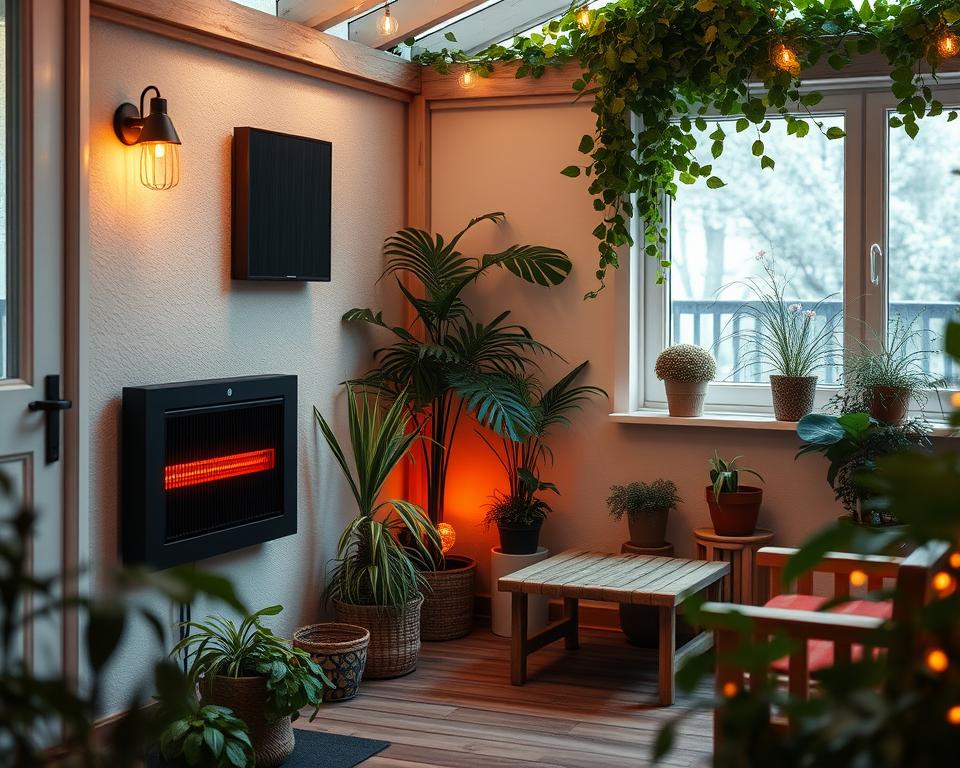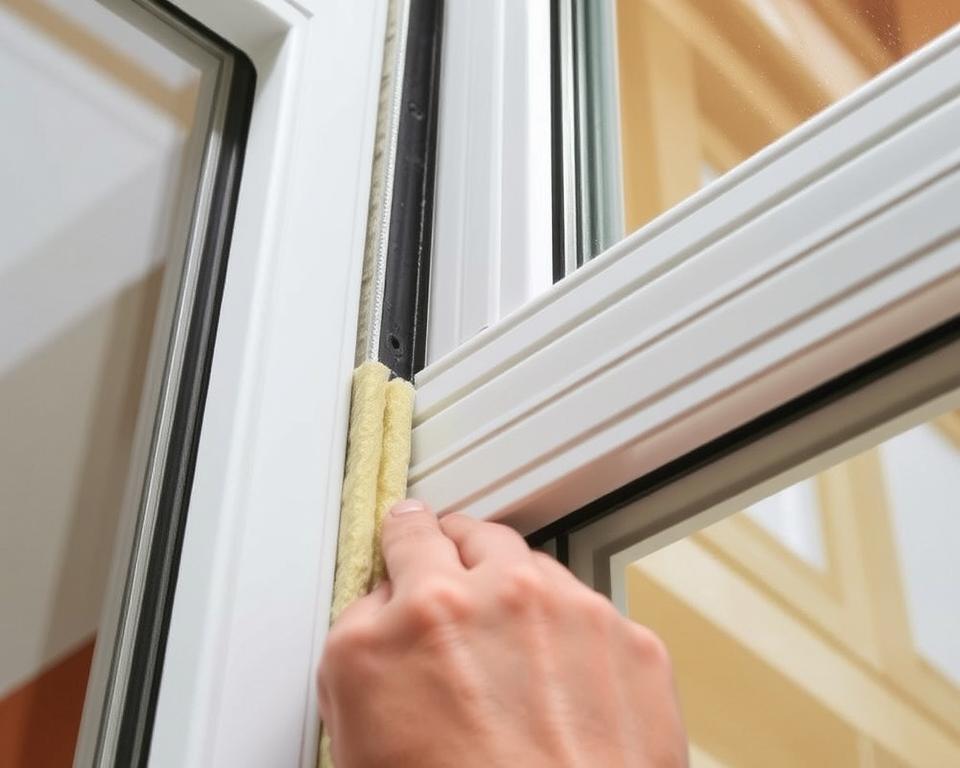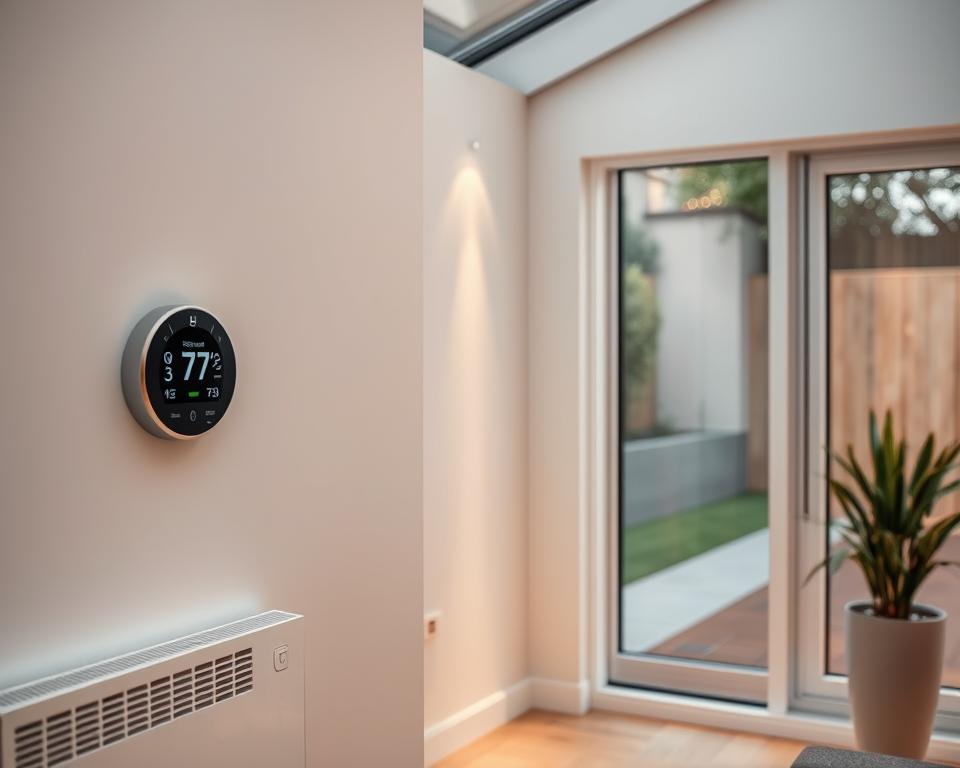how do i keep my garden room warm in the winter?

Garden rooms have transformed British gardens into versatile living spaces. These structures serve as home offices, creative studios, and peaceful retreats. Yet many owners struggle with winter garden room heating when temperatures drop.
The challenge lies in their unique construction. Unlike your main house, garden rooms sit separately from central heating systems. Their walls and windows often lack the thick insulation found in traditional buildings. This makes maintaining a warm garden office particularly tricky during harsh British winters.
Creating a heated garden studio doesn’t need to break the bank. Smart choices in garden room insulation and heating can turn your space into a year-round haven. From simple draught-proofing to installing efficient heating systems, various solutions exist for every budget.
This guide covers practical ways to create an energy-efficient garden room. You’ll discover which heating options work best, where heat typically escapes, and how to seal those costly gaps. Whether you use your space daily or occasionally, these tips will help you stay comfortable whilst keeping energy bills manageable.
Inhaltsverzeichnis
Key Takeaways
- Garden rooms lose heat faster than main houses due to lighter construction and separate heating systems
- Proper insulation in floors, walls, and ceilings forms the foundation of any warm garden room
- Double glazing and draught-proofing can reduce heat loss by up to 50 per cent
- Electric radiators, infrared panels, and heat pumps offer different benefits for various budgets
- Smart thermostats and timers help control heating costs whilst maintaining comfort
- Soft furnishings like thermal curtains and rugs provide extra warmth without using electricity
Understanding Heat Loss in Garden Rooms
Garden rooms face unique challenges when it comes to maintaining warmth during winter months. Their standalone nature and exposure to outdoor elements make heat loss prevention a critical consideration. Understanding where and how heat escapes helps you create a more comfortable space year-round.
Common Areas Where Heat Escapes
Every garden room has vulnerable spots where warmth seeps out. The main heat escape points include the floor, walls, roof, windows and doors. Each area contributes differently to overall heat loss, with walls typically accounting for the largest portion.
| Area | Heat Loss Percentage | Priority for Improvement |
|---|---|---|
| Walls | 35% | High |
| Roof | 25% | High |
| Windows & Doors | 25% | Medium |
| Floor | 15% | Medium |
The Impact of Single vs Double Glazing
Window choice dramatically affects thermal efficiency in your garden room. Single-glazed windows lose approximately 60% more heat than double-glazed alternatives. Triple glazing takes performance even further, creating an effective barrier against cold weather whilst reducing energy costs significantly.
Why Garden Rooms Get Colder Than Main Houses
Garden rooms cool faster than traditional homes for several reasons. Their exposed position leaves them vulnerable to wind and weather from all sides. Budget garden room construction often skimps on insulation, creating numerous opportunities for thermal bridging. The smaller thermal mass means these structures cannot store heat as effectively as brick-built homes, making consistent warmth harder to maintain.
Insulation Solutions for Year-Round Comfort
Proper insulation transforms your garden room from a seasonal space into a comfortable retreat throughout the year. The right combination of materials and installation techniques ensures excellent thermal performance whilst keeping energy costs manageable. Let’s explore the most effective ways to insulate floors, walls, ceilings and upgrade your glazing.
Floor Insulation Options
A well-insulated floor forms the foundation of a warm garden room. PIR insulation boards stand out as the preferred choice for many installers, offering exceptional performance with thicknesses between 100mm and 150mm. These rigid boards achieve impressive U-values as low as 0.15 W/m²K, meeting building regulations whilst maximising floor space.
Alternative options include:
- Polystyrene boards – budget-friendly with good moisture resistance
- Sheep’s wool – natural and breathable, ideal for eco-conscious builds
- Recycled plastic insulation – sustainable choice with solid performance
Wall and Ceiling Insulation Materials
Mineral wool remains popular for wall cavities, providing excellent acoustic properties alongside thermal benefits. Brands like Rockwool and Knauf deliver consistent results with U-values around 0.20 W/m²K when properly installed. For ceiling spaces, foam insulation or PIR boards from manufacturers like Kingspan and Celotex offer superior performance in limited spaces.
Upgrading Windows and Doors
Single glazing loses heat five times faster than insulated walls. Double or triple-glazed units with low-E coatings dramatically improve thermal performance, achieving U-values below 1.2 W/m²K. Composite doors outperform traditional timber options, combining attractive aesthetics with superior insulation properties. Professional fitting ensures proper sealing and prevents costly heat loss around frames.
How Do I Keep My Garden Room Warm in the Winter?
Creating a warm garden room during winter starts with understanding your space’s unique needs. Your winter heating solutions should match how often you use the room and its current insulation levels. Begin by checking for draughts around windows, doors, and where walls meet the floor.

Effective cold weather protection combines several strategies working together. Electric radiators offer quick heat for occasional use, whilst underfloor heating provides consistent warmth for daily activities. Oil-filled radiators retain heat well and continue warming your space even after switching off, making them cost-effective for extended use.
Smart garden room temperature control makes a significant difference to both comfort and energy bills. Programmable thermostats let you heat the space only when needed. Set temperatures to 18-20°C for working comfort, reducing to 12-15°C when empty. This approach maintains seasonal comfort without excessive heating costs.
Regular maintenance keeps your heating system efficient throughout winter. Clean radiator surfaces monthly, check door seals before autumn arrives, and bleed radiators if they develop cold spots. These simple tasks prevent heat loss and reduce energy consumption by up to 15%.
Remember that combining heating methods often works best. Use a primary heat source like radiators or underfloor heating, supplemented by infrared panels for targeted warmth where you sit or work. This layered approach ensures comfortable temperatures whilst managing running costs effectively.
Choosing the Right Heating System
Selecting proper garden room heaters transforms your outdoor space into a comfortable retreat throughout winter. Different heating options offer varying benefits, from quick warmth to long-term efficiency. Understanding each system’s advantages helps you make an informed decision that balances comfort with running costs.
Electric Radiators and Panel Heaters
Electric radiators provide instant warmth at the touch of a button. These efficient heating systems heat up within minutes and offer precise temperature control for individual rooms. Modern models feature built-in thermostats and timers, letting you programme heating schedules that match your usage patterns. Wall-mounted options save valuable floor space whilst oil-filled radiators retain heat longer after switching off.
Infrared Heating Solutions
Infrared panels work differently from traditional heaters by warming objects and people directly rather than heating the air. This eco-friendly heating method reduces energy waste and creates comfortable warmth faster. The sleek panels mount on walls or ceilings, blending seamlessly with your garden room’s design. Many users report feeling warmer at lower ambient temperatures with infrared technology.

Underfloor Heating Benefits
Underfloor heating distributes warmth evenly across your entire floor surface, eliminating cold spots. This invisible system frees up wall space and works brilliantly with tiles or wooden flooring. The gentle radiant heat rises naturally, creating consistent comfort from ground level upwards.
Air Source Heat Pumps
Air source heat pumps extract warmth from outside air, even in cold weather. These systems deliver exceptional efficiency ratings, producing three to four units of heat for every unit of electricity consumed. Government grants often help offset installation costs, making this sustainable option increasingly accessible.
| Heating Type | Installation Cost | Running Cost per Hour | Heat-up Time |
|---|---|---|---|
| Electric Radiators | £150-£500 | £0.30-£0.50 | 5-10 minutes |
| Infrared Panels | £200-£600 | £0.18-£0.35 | 1-3 minutes |
| Underfloor Heating | £800-£2,000 | £0.20-£0.40 | 30-60 minutes |
| Air Source Heat Pump | £2,000-£4,000 | £0.08-£0.15 | 20-30 minutes |
This running costs comparison shows air source heat pumps offer the lowest operating expenses despite higher initial investment. Infrared panels provide the quickest warmth, whilst underfloor heating suits those prioritising invisible, even heat distribution.
Maximising Natural Heat Sources
Harnessing natural warmth from the sun can significantly reduce your garden room’s heating costs whilst creating a comfortable environment. By understanding passive solar heating principles, you can transform your outdoor space into a cosy retreat that works with nature rather than against it.
The orientation of your garden room plays a crucial role in capturing sunlight. South-facing windows receive the most direct sunlight throughout the day, particularly during winter months when the sun sits lower in the sky. If a pure south orientation isn’t possible, south-west positioning offers excellent afternoon sun exposure when temperatures typically drop.

Incorporating thermal mass materials into your garden room design helps store and release heat naturally. Dense materials absorb warmth during sunny periods and radiate it back when temperatures fall. This creates a more stable indoor climate without constant heating adjustments.
| Thermal Mass Material | Heat Storage Capacity | Best Application |
|---|---|---|
| Concrete Floor | High | Full floor coverage |
| Brick Walls | High | Feature walls |
| Natural Stone | Very High | Decorative elements |
| Ceramic Tiles | Medium | Floor or wall sections |
Effective sunlight optimisation requires regular maintenance and strategic design choices. Keep windows spotlessly clean to maximise light transmission, and trim any overhanging branches that might block winter sun. Consider installing larger glazing on sun-facing walls whilst maintaining proper insulation standards. Strategic mirror placement can help distribute natural light deeper into the space, brightening darker corners and enhancing the feeling of warmth.
Draught-Proofing Your Garden Room
Cold air sneaking into your garden room can make it feel chilly and increase heating costs. Proper draught excluders and weather sealing can cut heat loss by up to 20%, making your space cosier whilst saving money on energy bills. Let’s explore practical ways to improve air tightness in your garden sanctuary.
Sealing Gaps Around Windows and Doors
Windows and doors are the biggest culprits for draughts in garden rooms. Even tiny gaps can let in surprising amounts of cold air. Start by examining the frames carefully – you’ll often find small spaces where the frame meets the wall.
For effective gap filling, use silicone sealant for narrow cracks or expanding foam for larger openings. These materials create a permanent seal that boosts thermal efficiency. Run your hand around frames on a windy day to feel for cold spots that need attention.

Installing Weather Strips and Door Sweeps
Quality weather strips transform draughty doors into snug barriers against the cold. You’ll find three main types:
- Brush strips – ideal for uneven surfaces
- Rubber seals – perfect for consistent gaps
- Foam strips – budget-friendly and easy to install
Door sweeps attach to the bottom of doors, blocking the gap where cold air loves to creep in. Installing these draught excluders costs between £20-£50 per door but pays for itself through energy savings.
Checking for Hidden Air Leaks
Some draughts hide in unexpected places. Light an incense stick on a breezy day and watch the smoke – it’ll dance wherever air tightness is compromised. Check around electrical sockets, pipe entries, and where walls meet floors or ceilings. These overlooked spots often need weather sealing to maintain your room’s thermal efficiency.
Smart Temperature Control and Thermostats
Installing smart heating controls transforms how you manage warmth in your garden room. These intelligent systems learn your routines and adjust temperatures automatically, creating comfort whilst reducing energy bills. Modern WiFi thermostats connect to your smartphone, letting you control heating from anywhere.
Temperature scheduling allows you to set different heat levels throughout the day. Your garden room stays cooler when empty and warms up just before you arrive. Most programmable thermostats offer multiple daily schedules, perfect for varying work patterns or weekend use.

Energy monitoring features reveal exactly how much heating costs. You can track daily, weekly, and monthly usage patterns to identify savings opportunities. Many systems display real-time consumption, helping you make informed decisions about temperature settings.
| Smart Thermostat Brand | Average Cost Savings | Key Features |
|---|---|---|
| Nest Learning Thermostat | 23% annually | Auto-scheduling, occupancy sensing |
| Hive Active Heating | 20% annually | Geolocation, holiday mode |
| Tado Smart Thermostat | 31% annually | Weather adaptation, open window detection |
Zone control capabilities let you heat specific areas independently. If your garden room has distinct work and relaxation spaces, each zone maintains its ideal temperature. This targeted approach prevents energy waste whilst ensuring comfort where needed.
Weather-responsive systems adjust heating based on outdoor conditions. When frost is forecast, your programmable thermostats can pre-emptively increase temperatures. During mild spells, they reduce output automatically, optimising both comfort and efficiency.
Soft Furnishings and Interior Design for Warmth
The right soft furnishings can transform a chilly garden room into a snug retreat during winter months. By selecting appropriate fabrics and design elements, you can significantly improve heat retention whilst creating inviting cosy interiors that feel welcoming year-round.
Thermal Curtains and Blinds
Quality thermal curtains can reduce heat loss through windows by up to 25 per cent. These specialised window treatments feature multiple layers of heat retention fabrics that trap air and create an insulating barrier. For optimal efficiency, choose curtains that extend beyond the window frame and reach the floor.
Insulating blinds offer another excellent option. Cellular blinds, also known as honeycomb blinds, create air pockets that act as natural insulators. Roman blinds with thermal backing combine style with functionality, making them perfect for garden rooms where aesthetics matter.
Rugs and Carpets for Floor Insulation
Adding thick rugs to hard floors provides both comfort and extra insulation. Wool rugs work particularly well, as they naturally regulate temperature and feel warm underfoot. Layer smaller rugs for added depth and insulation in seating areas.
Using Warm Colours and Textures
Warm décor choices create psychological warmth that complements physical heating. Rich reds, burnt oranges, and deep browns make spaces feel cosier. Incorporate these colours through cushions, throws, and wall hangings.
Textured fabrics like wool, fleece, and velvet add visual warmth whilst providing actual insulation. Drape soft throws over furniture and add plump cushions to seating areas. These touches create inviting spaces whilst helping trap heat where you need it most.
Cost-Effective Heating Tips and Energy Efficiency
Keeping your garden room warm doesn’t have to break the bank. Smart heating strategies and available financial support can make heating cost reduction achievable whilst maintaining a comfortable temperature throughout winter. Simple adjustments to your heating routine combined with strategic planning can significantly lower your energy bills.
Timer Settings and Zone Heating
Programming your heating system with timer controls is one of the most effective energy saving tips for garden rooms. Set your heating to activate 30 minutes before you plan to use the space and switch off when you leave. This approach can reduce heating bills by up to 30%.
Zone heating takes efficiency improvements one step further by warming only occupied areas. If your garden room has distinct zones for work and relaxation, consider installing separate thermostats to control each area independently.
Comparing Running Costs of Different Systems
Understanding the hourly running costs helps make informed decisions about heating cost reduction:
| Heating Type | Hourly Cost Range | Best For |
|---|---|---|
| Electric Heaters | £0.30 – £0.50 | Quick heating, occasional use |
| Oil-Filled Radiators | £0.20 – £0.40 | Steady heat, medium-sized rooms |
| Infrared Panels | £0.15 – £0.30 | Targeted heating, well-insulated spaces |
| Heat Pumps | £0.10 – £0.20 | Long-term efficiency, regular use |
Government Grants and Incentives
Several government grants can help offset installation costs. The ECO4 scheme provides funding for insulation improvements to eligible households. The Boiler Upgrade Scheme offers particularly generous support, with grants up to £7,500 available for heat pump installations.
The green homes grant successor programmes focus on whole-house efficiency improvements. Local councils often run additional schemes supporting energy-efficient upgrades. Check your council’s website for current opportunities, as these grants vary by location and availability changes regularly.
Conclusion
Creating a winter-ready garden room doesn’t have to be complicated or expensive. The key is combining several strategies that work together to maintain year-round comfort. Start with quality insulation in your floors, walls and ceiling. This forms the foundation of any warm garden space and reduces the amount of heating you’ll need.
Next, select a heating system that matches your usage patterns and budget. Electric radiators work well for occasional use, whilst underfloor heating provides consistent warmth for daily occupied spaces. Add draught-proofing around windows and doors to prevent cold air from sneaking in. These energy-efficient solutions help keep running costs manageable throughout winter.
Don’t forget the finishing touches that make a real difference. Thermal curtains, thick rugs and warm-coloured furnishings all contribute to creating a cosy atmosphere. Smart thermostats and timer controls ensure you’re only heating the space when needed. This heating summary shows that with the right combination of insulation, heating and thoughtful design choices, your garden room can become a comfortable retreat even on the coldest days.
FAQ
What’s the cheapest way to heat my garden room in winter?
The most cost-effective heating solution depends on your usage patterns. For occasional use, electric panel heaters with timer controls work well, costing around £0.30-£0.50 per hour. However, for daily use, investing in an air source heat pump offers the lowest running costs at approximately £0.10-£0.20 per hour. Combining any heating system with proper insulation and draught-proofing will significantly reduce your overall heating expenses.
How much insulation do I need for a winter-ready garden room?
For year-round comfort, aim for at least 100-150mm of PIR board insulation in floors, 75-100mm in walls, and 150-200mm in the ceiling. Products like Kingspan or Celotex offer excellent thermal performance. Don’t forget to insulate around windows and doors, as these areas can account for up to 25% of heat loss in a typical garden room.
Can I install underfloor heating in an existing garden room?
Yes, you can retrofit electric underfloor heating in an existing garden room, though it requires lifting the current flooring. Low-profile systems are available that add only 15-20mm to your floor height. However, it’s more cost-effective to install underfloor heating during initial construction. For existing rooms, consider infrared panels or efficient electric radiators as less disruptive alternatives.
What temperature should I keep my garden room when not in use?
Maintain a minimum temperature of 12-14°C when your garden room is unoccupied. This prevents dampness, protects any equipment or furnishings, and allows for quicker warm-up times when needed. Smart thermostats like Nest or Hive can automatically adjust temperatures based on your schedule, potentially saving 20-30% on heating costs.
Are government grants available for garden room insulation?
Yes, several schemes may apply. The ECO4 scheme offers grants for insulation improvements to eligible households, whilst the Boiler Upgrade Scheme provides up to £7,500 towards air source heat pump installation. Check with your local council for additional energy efficiency grants. Note that garden rooms must meet certain criteria and be connected to your main property’s heating system to qualify for some schemes.
How can I reduce condensation in my heated garden room?
Condensation occurs when warm air meets cold surfaces. Ensure proper ventilation by installing trickle vents or using a dehumidifier. Maintain consistent temperatures rather than allowing the room to cool completely between uses. Install proper vapour barriers during insulation, and consider double or triple glazing with warm-edge spacers to reduce condensation on windows.
What’s the difference between infrared heating and conventional radiators?
Infrared panels heat objects and people directly rather than warming the air, providing instant warmth and reducing running costs by 30-40% compared to conventional heaters. They’re ideal for garden rooms as they work efficiently even in draughty spaces. Conventional radiators heat the air, which can be less efficient in poorly insulated rooms but provides more even background warmth.
How do I stop my garden room floor from feeling cold?
Cold floors are common in garden rooms due to insufficient insulation. Add thick rugs or carpet with quality underlay for immediate improvement. For a permanent solution, ensure your floor has at least 100mm of insulation. Consider installing electric underfloor heating mats if renovating. Floating floors with insulation boards underneath can also significantly improve floor warmth without major construction work.

